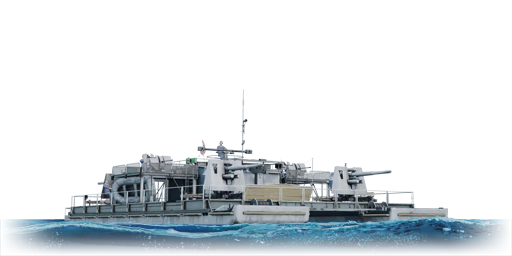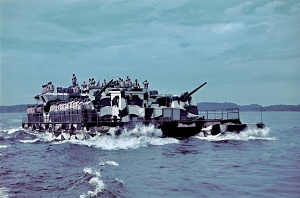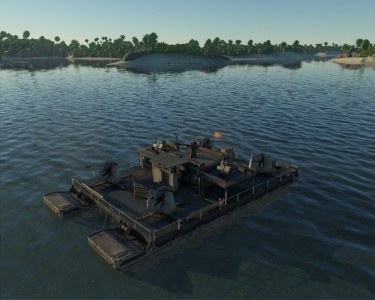Difference between revisions of "SF40 Heavy"
Jareel_Skaj (talk | contribs) m (fuze -> fuse, VT -> proximity (to make it more clear - not everyone know what "VT" is), added Barges to →See also) |
(description) |
||
| Line 11: | Line 11: | ||
== Description == | == Description == | ||
<!-- ''In the first part of the description, cover the history of the ship's creation and military application. In the second part, tell the reader about using this ship in the game. Add a screenshot: if a beginner player has a hard time remembering vehicles by name, a picture will help them identify the ship in question.'' --> | <!-- ''In the first part of the description, cover the history of the ship's creation and military application. In the second part, tell the reader about using this ship in the game. Add a screenshot: if a beginner player has a hard time remembering vehicles by name, a picture will help them identify the ship in question.'' --> | ||
| − | The ''' | + | The '''Siebelfähre 40''' (Siebel ferry 40), or just the '''SF40''' for short, was a series of 200 shallow-draft catamaran landing craft developed by the Wehrmacht in 1941. Originally intended to be used for the planned invasion of the United Kingdom, it was later repurposed into a variety of roles. Ranging from troop transport, ad-hoc gunboat, floating flak battery, towed convoy escort, or even as a minelayer. Due to its simple design, the SF40 can be easily converted back-and-forth to fit with various needs. The in-game "SF40 Heavy" is based on the specific SF40 outfitted with four 88 mm flak cannons deployed in Lahdenpohja on the Finnish-Soviet border. |
| + | |||
| + | Introduced in [[Update 1.79 "Project X"]] in the fleet closed beta test as the '''SF40 Schwere''', the {{PAGENAME}} is the first of the slow but hard-hitting barges of the German coastal tree. It lives up with its "Heavy" designation thanks to a heavy armaments of four 88 mm flak cannons, up to 3 of which can be targeted at a surface target. This allows the SF40 Heavy to dismantle any lesser coastal vessel with a few well-placed hits, even at long ranges. However, the SF40 Heavy is quite slow and sluggish, and therefore is vulnerable up close. Thus, it is advised to stay out of the firefights and pick off the enemy one by one with your cannons. | ||
== General info == | == General info == | ||
| Line 68: | Line 70: | ||
'''Pros:''' | '''Pros:''' | ||
| − | * Powerful 88 mm guns can destroy | + | * Powerful 88 mm guns can destroy most of the common target with just a few hits |
| − | * Can take | + | * Can face up to three guns at the surface targets, or all fours against air targets |
| + | * Two 20 mm autocannons provides sufficient surface and anti-air coverage | ||
| + | * Durable hull can take a considerable amount of punishments | ||
* Velocity and flat trajectory of shells makes it suitable to hang back and snipe enemies from >2 km | * Velocity and flat trajectory of shells makes it suitable to hang back and snipe enemies from >2 km | ||
'''Cons:''' | '''Cons:''' | ||
| − | * | + | * Terrible mobility; very slow and sluggish to handle |
| − | * Large target | + | * Large target, easy to hit from the distance |
| − | * Lacks an AP shell for dealing with armoured targets | + | * Lacks an AP shell for dealing with armoured targets or early destroyers |
| − | |||
| − | |||
* Easy to torpedo or dive bomb due to its size and sluggishness | * Easy to torpedo or dive bomb due to its size and sluggishness | ||
* Lacks a proximity fuse shell, only has timed and impact fuses | * Lacks a proximity fuse shell, only has timed and impact fuses | ||
| Line 84: | Line 86: | ||
== History == | == History == | ||
<!-- ''Describe the history of the creation and combat usage of the ship in more detail than in the introduction. If the historical reference turns out to be too long, take it to a separate article, taking a link to the article about the ship and adding a block "/History" (example: <nowiki>https://wiki.warthunder.com/(Ship-name)/History</nowiki>) and add a link to it here using the <code>main</code> template. Be sure to reference text and sources by using <code><nowiki><ref></ref></nowiki></code>, as well as adding them at the end of the article with <code><nowiki><references /></nowiki></code>. This section may also include the ship's dev blog entry (if applicable) and the in-game encyclopedia description (under <code><nowiki>=== In-game description ===</nowiki></code>, also if applicable).'' --> | <!-- ''Describe the history of the creation and combat usage of the ship in more detail than in the introduction. If the historical reference turns out to be too long, take it to a separate article, taking a link to the article about the ship and adding a block "/History" (example: <nowiki>https://wiki.warthunder.com/(Ship-name)/History</nowiki>) and add a link to it here using the <code>main</code> template. Be sure to reference text and sources by using <code><nowiki><ref></ref></nowiki></code>, as well as adding them at the end of the article with <code><nowiki><references /></nowiki></code>. This section may also include the ship's dev blog entry (if applicable) and the in-game encyclopedia description (under <code><nowiki>=== In-game description ===</nowiki></code>, also if applicable).'' --> | ||
| − | The Siebelfähre was designed by Friedrich Siebel, owner of a lesser-known German aircraft manufacturing company bearing his name. Siebel's idea was to provide the German army with a much needed easily mass-produced and effective transport vessel for the planned invasion of Britain. | + | [[File:JSdia173.jpg|300px|thumb|right|An SF40 with heavy flak battery in the town of Lahdenpohja, Finland (Lakhdenpokhya in the modern-day Russia).]]The Siebelfähre was designed by Friedrich Siebel, owner of a lesser-known German aircraft manufacturing company bearing his name. Siebel's idea was to provide the German army with a much needed easily mass-produced and effective transport vessel for the planned invasion of Britain. |
His ferry would be a construction utilising parts of Bailey bridges and pontoons, which would make up the two barges connected in a catamaran style by a wooden deck. The vessel was supposed to be powered by aircraft engines and could easily be disassembled and reassembled thanks to its modular construction, allowing for the boat to also be transported by land. | His ferry would be a construction utilising parts of Bailey bridges and pontoons, which would make up the two barges connected in a catamaran style by a wooden deck. The vessel was supposed to be powered by aircraft engines and could easily be disassembled and reassembled thanks to its modular construction, allowing for the boat to also be transported by land. | ||
Latest revision as of 11:50, 23 November 2024
| This page is about the German anti-air ferry SF40 Heavy. For the 20 mm version, see SF40 Light. |
Contents
Description
The Siebelfähre 40 (Siebel ferry 40), or just the SF40 for short, was a series of 200 shallow-draft catamaran landing craft developed by the Wehrmacht in 1941. Originally intended to be used for the planned invasion of the United Kingdom, it was later repurposed into a variety of roles. Ranging from troop transport, ad-hoc gunboat, floating flak battery, towed convoy escort, or even as a minelayer. Due to its simple design, the SF40 can be easily converted back-and-forth to fit with various needs. The in-game "SF40 Heavy" is based on the specific SF40 outfitted with four 88 mm flak cannons deployed in Lahdenpohja on the Finnish-Soviet border.
Introduced in Update 1.79 "Project X" in the fleet closed beta test as the SF40 Schwere, the SF40 Heavy is the first of the slow but hard-hitting barges of the German coastal tree. It lives up with its "Heavy" designation thanks to a heavy armaments of four 88 mm flak cannons, up to 3 of which can be targeted at a surface target. This allows the SF40 Heavy to dismantle any lesser coastal vessel with a few well-placed hits, even at long ranges. However, the SF40 Heavy is quite slow and sluggish, and therefore is vulnerable up close. Thus, it is advised to stay out of the firefights and pick off the enemy one by one with your cannons.
General info
Survivability and armour
The SF40 Heavy has the following armour layout:
- 2 cm/65 C/38 automatic cannon gunshields: 8 mm, hardened armour
- 8.8 cm Flak.36 cannon gunshield: 8 mm, antifragmentation armour
- Deckhouse: 10 mm, rolled homogeneous armour
- Hull: 8 mm, steel
- Superstructure: 20 mm, steel
The SF40 Heavy's armour is basically the same as SF40 Light with changes around guns. It lacks armoured turret platforms, so guns taken out with HE shells might occur more often. Besides armour, the SF40 Heavy can be a tough opponent to sink since most HE shots will hit the deck with no damage to the hull. Also, the rather high crew complement of 47 (5 more than the SF40 Light) makes it harder to incapacitate by killing crew, though this is still the easiest way to take out this barge. Clever captains will try to angle the ship to allow aiming 3 guns on enemy targets, but this also makes the opposing ship able to hit only one of the four ammo storages. Even though this storage is high above the waterline, hitting it doesn't happen often, since the bridge in the center is a way easier target to aim at.
Mobility
The SF40 Heavy's top speed is terrible. At 28 km/h (Arcade) / 22 km/h (Realistic) when fully upgraded, it might take several minutes for it to reach its destination. Always watch out for enemy PT boats and their torpedoes, as they are the greatest threat to the SF40 Heavy's survival.
Modifications and economy
Armament
Primary armament
The 8.8 cm FlaK guns mounted on the SF40 Heavy have a good reload rate, accuracy, and muzzle velocity, thus making it easy to aim and control. The access to distance-fuse high-explosive shells and an elevation up to 85° degrees is very effective against big attackers and bombers flying high and slow. The reload rate also makes the SF40 a really dangerous opponent. However, these guns can be quite clunky against fast PT boats due to their relatively slow traverse speed.
| Penetration statistics | |||||||
|---|---|---|---|---|---|---|---|
| Ammunition | Type of warhead |
Penetration @ 0° Angle of Attack (mm) | |||||
| 100 m | 1,000 m | 2,000 m | 3,000 m | 4,000 m | 5,000 m | ||
| Sprgr. L/4.5 | HE | 11 | 11 | 11 | 11 | 11 | 11 |
| 8.8 cm Sprgr. L/4.5 Zt.Z | HE-TF | 11 | 11 | 11 | 11 | 11 | 11 |
| Shell details | ||||||||||||
|---|---|---|---|---|---|---|---|---|---|---|---|---|
| Ammunition | Type of warhead |
Velocity (m/s) |
Projectile mass (kg) |
Fuse delay (m) |
Fuse sensitivity (mm) |
Explosive mass (TNT equivalent) (g) |
Ricochet | |||||
| 0% | 50% | 100% | ||||||||||
| Sprgr. L/4.5 | HE | 820 | 9 | 0 | 0.1 | 698 | 79° | 80° | 81° | |||
| 8.8 cm Sprgr. L/4.5 Zt.Z | HE-TF | 820 | 9 | 0 | 0.1 | 698 | 79° | 80° | 81° | |||
Secondary armament
The 20 mm multipurpose cannons with a fire rate of 480 rounds/min is very effective against small boats and lightly armoured ships as well as planes in close combat, thus making the SF 40 also effective against light and fast naval and air targets.
- Universal: AP-T · AP · HEF-T · HEF
- 20 mm HET magazines: HEF · HEF-T · HEF · AP
- 20 mm APT magazines: AP · AP-T · AP · HEF
| Penetration statistics | |||||||
|---|---|---|---|---|---|---|---|
| Ammunition | Penetration @ 0° Angle of Attack (mm) | ||||||
| 10 m | 100 m | 500 m | 1,000 m | 1,500 m | 2,000 m | ||
| HEF-T | 2 | 2 | 2 | 2 | 2 | 2 | |
| AP | 36 | 35 | 27 | 20 | 15 | 11 | |
| AP-T | 36 | 35 | 27 | 20 | 15 | 11 | |
| HEF | 2 | 2 | 2 | 2 | 2 | 2 | |
| Shell details | ||||||||||||
|---|---|---|---|---|---|---|---|---|---|---|---|---|
| Ammunition | Velocity (m/s) |
Projectile mass (kg) |
Fuse delay (m) |
Fuse sensitivity (mm) |
Explosive mass (TNT equivalent) (g) |
Ricochet | ||||||
| 0% | 50% | 100% | ||||||||||
| HEF-T | 835 | 0.12 | 0 | 0.1 | 10.54 | 79° | 80° | 81° | ||||
| AP | 785 | 0.15 | - | - | - | 47° | 60° | 65° | ||||
| AP-T | 785 | 0.15 | - | - | - | 47° | 60° | 65° | ||||
| HEF | 835 | 0.12 | 0 | 0.1 | 10.54 | 79° | 80° | 81° | ||||
Usage in battles
Describe the technique of using this ship, the characteristics of her use in a team and tips on strategy. Abstain from writing an entire guide – don't try to provide a single point of view, but give the reader food for thought. Talk about the most dangerous opponents for this vehicle and provide recommendations on fighting them. If necessary, note the specifics of playing with this vehicle in various modes (AB, RB, SB).
Pros and cons
Pros:
- Powerful 88 mm guns can destroy most of the common target with just a few hits
- Can face up to three guns at the surface targets, or all fours against air targets
- Two 20 mm autocannons provides sufficient surface and anti-air coverage
- Durable hull can take a considerable amount of punishments
- Velocity and flat trajectory of shells makes it suitable to hang back and snipe enemies from >2 km
Cons:
- Terrible mobility; very slow and sluggish to handle
- Large target, easy to hit from the distance
- Lacks an AP shell for dealing with armoured targets or early destroyers
- Easy to torpedo or dive bomb due to its size and sluggishness
- Lacks a proximity fuse shell, only has timed and impact fuses
History
His ferry would be a construction utilising parts of Bailey bridges and pontoons, which would make up the two barges connected in a catamaran style by a wooden deck. The vessel was supposed to be powered by aircraft engines and could easily be disassembled and reassembled thanks to its modular construction, allowing for the boat to also be transported by land.
The idea was met with great enthusiasm from the German military, and an order for 400 units of this ferrycraft soon followed. The order encompassed more than just one version of the vessel, however. For instance, some versions were specialised to perform anti-air duties and were meant to cover the landing troops from air attacks. These were equipped with light 20 mm and 37 mm AA guns up to the heavy FlaK 88 mm cannon, depending on the version.
However, before all 400 vessels could be made, the Invasion of Britain was cancelled, and thus the need for the Siebelfähre also disappeared below the waves. Nonetheless, around 200 of these vessels were still made before the order was cancelled and a majority of them found use in transport and mine-laying operations in the Black Sea and the Mediterranean. The Siebelfähre saw use right up to the end of the war, and some vessels continued serving well into the 1960s as civilian ferries.
- From Devblog
Media
- Skins
- Images
See also
External links
| Germany barges | |
|---|---|
| Anti-air ferries | SF40 Light · SF40 Heavy |
| Naval ferry barges | AF D1 · AF D3 |







